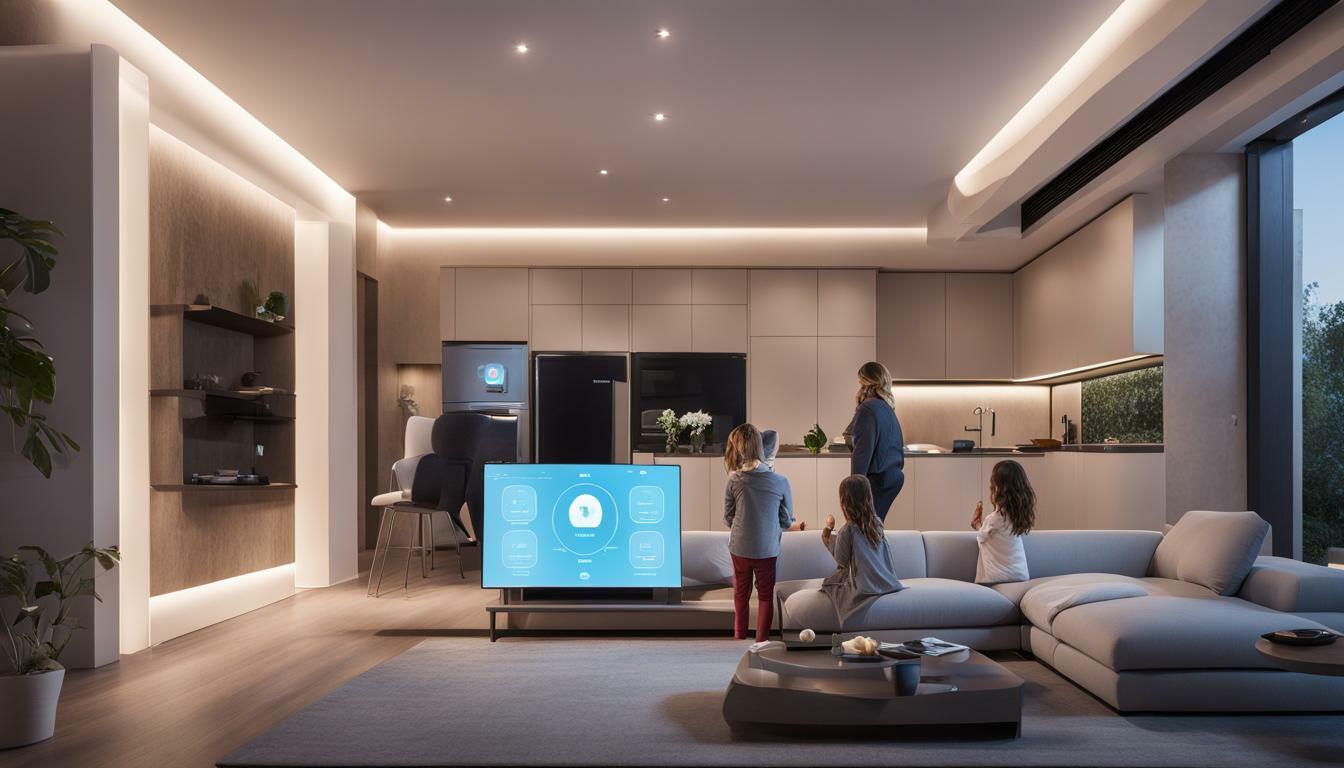
In today’s fast-paced world, technology has become an integral part of daily life. From smartphones to smart cars, technology has made our lives more convenient and connected. One area where technology has had a significant impact is in the home, with the rise of smart homes.
But what exactly is a smart home? In simple terms, a smart home is a house that is equipped with devices that can be controlled remotely or can automate certain tasks. These devices are interconnected, creating a seamless and efficient living environment.
Key Takeaways
- A smart home is a house equipped with devices that can be controlled remotely or automate certain tasks
- Smart devices are interconnected, creating a seamless and efficient living environment
- Smart homes offer benefits such as convenience, energy efficiency, increased security, and improved comfort
The Evolution of Smart Homes
The concept of a smart home is not new. In fact, the idea of a home that can be controlled and managed through automation has been around for decades. However, it is the advancements in technology that have made smart homes more accessible and practical for everyday consumers.
One of the earliest examples of smart home technology was the X10 protocol, which dates back to the 1970s. This system used power lines to transmit signals between devices and allowed homeowners to control lighting and appliances from a central panel.
As technology continued to evolve, so did smart home devices. In the 1990s, wireless technologies such as Zigbee and Z-Wave emerged, paving the way for more sophisticated and interconnected smart home gadgets. These systems enabled the management of devices through a single hub, making the process of setting up and controlling a smart home much simpler.
The Internet of Things (IoT) in Smart Homes
However, it was the rise of the Internet of Things (IoT) that truly revolutionized the concept of a connected home. By enabling devices to communicate and exchange data over the internet, the IoT opened up a realm of possibilities for smart home technology.
Today, smart home technology has become even more advanced, with the inclusion of machine learning and artificial intelligence. Smart homes are now able to learn and adapt to the needs and preferences of their occupants, offering an even more personalized experience.
| Decade | Advancements in Smart Home Technology |
|---|---|
| 1970s | X10 protocol for home automation |
| 1990s | Wireless technologies such as Zigbee and Z-Wave |
| 2000s | Introduction of smartphone apps for remote control of smart devices |
| 2010s | The Internet of Things (IoT) and machine learning in smart homes |
“Technology is just a tool. In terms of getting the kids working together and motivating them, the teacher is the most important.” – Bill Gates
As smart home technology continues to develop and evolve, it is safe to say that the future of smart homes is bright. With the potential to improve energy efficiency, increase security, and enhance the overall quality of life for homeowners, it is no wonder that smart homes are becoming an increasingly popular choice for modern living.
Benefits of a Smart Home
Integrating smart home technology into your home can have numerous benefits, making your daily life more efficient and convenient. Here are some advantages of a smart home:
- Convenience: With smart home devices, you can control various functions of your home remotely from your smartphone or voice assistants like Amazon’s Alexa or Google Assistant. Imagine being able to adjust the thermostat, turn off the lights, or lock the doors without getting out of bed or leaving your couch.
- Energy efficiency: Smart home technology can help you save energy and reduce your utility bills by automating your home’s heating, cooling, and lighting systems. With features like motion sensors and scheduling, you can ensure that your lights and appliances are only in use when you need them.
- Increased security: Smart home devices like cameras, doorbells, and smart locks can help you keep an eye on your home, even when you’re away. You can receive alerts and monitor activity in and around your home through your smartphone, providing peace of mind and an added layer of security.
- Improved comfort: Smart home technology can help you create a more comfortable living environment by allowing you to customize your home’s temperature, lighting, and other features to your preferences. With features like voice control, you can easily adjust the settings without even lifting a finger.
“Smart home technology can enhance the overall quality of life for homeowners.”
These benefits can help you save time, reduce stress, and increase your comfort, giving you more time to focus on the things that matter most.
Smart Home Technology Explained
Smart home technology involves the use of various devices that can connect and communicate with each other, providing homeowners with greater control and automation over their homes. These devices are usually designed to be user-friendly and can be controlled through a centralized system or smartphone app.
Smart Home Hubs
A smart home hub serves as the central control system for all the smart devices within a home. It allows users to set up and configure their devices, link them together, and create automated routines. Some popular smart home hubs include Amazon Echo, Google Nest Hub, and Samsung SmartThings.
Sensors
Sensors are devices that can detect changes in the environment and trigger actions based on those changes. For example, a motion sensor can detect movement in a room and turn on the lights automatically. Other types of sensors include temperature sensors, humidity sensors, and contact sensors.
Smart Appliances
Smart appliances refer to household appliances that can connect to a home network and be controlled remotely or automated. Examples include smart refrigerators, ovens, washing machines, and coffee makers. These appliances can often be controlled through a smartphone app, allowing users to check their status from anywhere.
Voice Assistants
Voice assistants, such as Amazon Alexa and Google Assistant, allow users to control their smart home devices using voice commands. Users can ask their voice assistant to perform tasks such as turning on the lights, adjusting the thermostat, and playing music.
Smart home technology offers homeowners a range of benefits, including greater convenience, energy efficiency, and improved security. By understanding the various components that make up a smart home system, users can make informed decisions when selecting devices and configuring their smart homes.
Smart Home Security
Ensuring the security of your smart home is paramount. With each device connected to the internet, there is a potential vulnerability that could be exploited by cybercriminals. Fortunately, there are measures you can take to protect your smart home from unauthorized access and threats.
One of the first steps to securing your smart home is to use strong and unique passwords for each device and account. Avoid using default passwords, which are easy for hackers to guess. Instead, use a combination of letters, numbers, and symbols. Consider using a password manager to generate and store your passwords securely.
Another important security feature is encryption, which provides a secure communication channel between your devices and the internet. Look for devices that use encryption protocols such as WPA2 to protect your wireless network or SSL/TLS for secure communication with cloud-based services.
Authentication is also critical for smart home security. Devices should require a password or other form of authentication before being accessed remotely. Two-factor authentication is an even stronger security measure that can prevent unauthorized access to your smart home.
Finally, keep your devices and software updated with the latest security patches. Manufacturers regularly release updates to fix security flaws and vulnerabilities. Set up automatic updates when possible to ensure your devices are always protected.
Popular Smart Home Devices
Smart home technology has come a long way in recent years, and there is now a vast range of devices available to enhance your daily life. Here are some of the most popular smart home devices:
| Device | Description |
|---|---|
| Smart Thermostat | Allows you to control your home’s temperature remotely, saving energy and reducing costs. |
| Smart Lighting | Enables you to control your home’s lighting with the touch of a button or a voice command. |
| Smart Lock | Allows you to lock and unlock your home using your smartphone, ensuring your home is secure at all times. |
| Smart Speaker | Acts as a central hub for all your smart home devices, allowing you to control them with your voice. |
| Smart Camera | Provides real-time monitoring of your home, sending alerts to your smartphone when motion is detected. |
These devices can be integrated into your smart home system, allowing you to control them all from one device, such as your smartphone or voice assistant. By customizing your smart home system to fit your lifestyle, you can make your home not only more efficient but also more convenient and comfortable.
Integrating Smart Home Devices
Now that you have a basic understanding of smart home devices and their functionalities, you may wonder how to manage and control them efficiently. This is where home automation comes into play.
Home automation allows you to integrate multiple devices and systems into a centralized control system. This can be done through voice assistants, remote controls, or smartphone apps. By doing so, you can easily manage and control smart home functions such as lighting, temperature, and security with a few taps on your smartphone.
| Benefits of Home Automation: |
|---|
| Convenience: Home automation provides a seamless and intuitive user-friendly experience, allowing homeowners to control various devices with ease. |
| Energy Efficiency: With home automation, you can reduce your energy consumption by automating your home’s temperature, lighting, and appliances. |
| Increased Security: Home automation allows you to monitor and control your home security, giving you peace of mind even when away from home. |
Whether you want to turn on the lights, lock the doors, or adjust the thermostat, home automation offers a convenient and efficient way to manage your smart home devices. By integrating your devices, you can create a cohesive and personalized smart home experience that fits your needs and lifestyle.
The Future of Smart Homes
The future of smart homes is an exciting prospect, with many new advancements and innovations on the horizon. One of the key trends we can expect to see is the integration of artificial intelligence (AI) and machine learning into smart home technology.
AI and machine learning will allow for more personalized and efficient automation in smart homes, with the ability to learn from user behaviors and adjust accordingly. For example, your smart home could learn your preferred temperature settings and adjust the thermostat accordingly without any input from you.
Voice recognition technology is also expected to become even more prominent in smart homes, with the potential for seamless integration between voice assistants and other devices. This means that you could control everything from your lights to your security system with simple voice commands.
Smart Home Health Monitoring
Another area of potential growth in smart home technology is health monitoring. With the population aging and more people opting for home care, smart home devices could play a significant role in monitoring health and providing assistance when needed.
For example, smart home sensors could detect if an elderly person falls and notify emergency services automatically. Smart home devices could also be used to monitor vital signs such as heart rate and blood pressure, alerting caregivers or medical professionals if any irregularities are detected.
Energy Efficiency and Sustainability
Energy efficiency and sustainability will also be key considerations in the future of smart homes. With the increasing adoption of renewable energy sources, smart homes will be able to integrate with solar panels and other green energy sources to reduce reliance on traditional power grids.
Smart home technology will also become more advanced in managing energy usage, with the ability to detect and control energy consumption in real-time. This means that your smart home could adjust lighting and temperature settings based on your presence in the room, reducing unnecessary energy usage.
The future of smart homes is full of potential and exciting possibilities. As technology continues to advance, we can expect even greater levels of convenience, security, and sustainability in our homes.
Smart Home Integration Challenges
While smart homes offer numerous benefits, integrating smart home devices and systems may come with some challenges. It is essential to consider these factors before investing in smart home technology to ensure a smooth transition.
Compatibility Issues
One of the primary challenges of integrating smart home devices is ensuring compatibility. Not all smart devices work together seamlessly, and compatibility issues may arise when attempting to integrate devices from different manufacturers. To avoid this issue, ensure that all devices are compatible with each other or invest in a smart home hub that can manage multiple devices.
The Learning Curve for New Technology
Integrating smart home devices requires a certain level of technical knowledge, and some users may struggle with the learning curve. It may take time to understand how to use and manage multiple devices, especially for those who are not tech-savvy. To overcome this challenge, take the time to learn about the devices, or invest in professional installation and setup.
Privacy Concerns
Smart home devices collect and transmit user data, raising concerns about privacy and security. Users need to be aware of potential privacy risks and take measures to protect their data. Ensure that all devices are secured with strong passwords, and consider investing in devices with end-to-end encryption and other security features.
Conclusion
By now, you should have a better understanding of what smart homes are, how they have evolved over time, and the benefits they offer. With smart home technology, you have the power to automate your home, enhance security, increase energy efficiency, and elevate your overall quality of life.
As you explore the range of smart home devices available on the market, keep in mind that there may be some challenges to overcome. However, with patience and willingness to learn, you can integrate these devices and create a seamless system that meets your needs.
Looking Towards the Future
The future of smart homes is exciting and full of potential, with developments in AI, machine learning, and voice recognition on the horizon. As these technologies continue to evolve, the possibilities for the smart home landscape are endless.
So why not join the smart home revolution and see how it can transform your daily life? With a little research and effort, you can create a home that is not only connected but also secure, efficient, and convenient. Welcome to the world of smart homes!
FAQ
Q: What is a smart home?
A: A smart home refers to a residence that incorporates technology to automate and control various aspects of daily life, such as lighting, appliances, security systems, and more.
Q: What are the benefits of having a smart home?
A: Smart homes offer numerous advantages, including increased convenience, energy efficiency, improved security, and enhanced comfort.
Q: How does smart home technology work?
A: Smart home technology relies on interconnected devices, such as sensors, smart appliances, and voice assistants, which communicate with each other and can be controlled through a centralized system or smartphone app.
Q: Are smart homes secure?
A: Smart home security is a top priority, and various measures, such as encryption, authentication, and secure network protocols, are in place to protect smart homes from cyber threats and unauthorized access.
Q: What are some popular smart home devices?
A: Popular smart home devices include smart thermostats, smart lighting, smart locks, smart speakers, and smart cameras, among others.
Q: How can smart home devices be integrated?
A: Smart home devices can be integrated and controlled through centralized systems or smartphone apps, allowing for a seamless and user-friendly experience.
Q: What does the future hold for smart homes?
A: The future of smart homes may involve advancements in technologies such as artificial intelligence, machine learning, and voice recognition, further enhancing the capabilities and functionalities of smart home systems.
Q: What challenges may arise when integrating smart home devices?
A: Challenges in smart home integration can include compatibility issues, the learning curve for new technology, and potential privacy concerns that need to be addressed.




